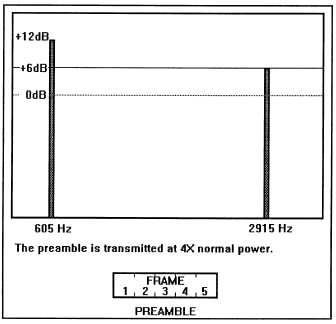reply, it automatically switches to the transmit mode
and calls up the next PU address. After all the units in
the net have been polled, the NCS transmits its own
data and the process is continuously repeated. The
Roll Call mode provides all PUS with continuous,
near real-time exchange of tactical information.
Broadcast
When the Broadcast mode is used, one PU will
continuously send a series of data transmissions to all
the members of the net. Once manually initiated, the
transmission will continue to be sent automatically
until the operator manually stops it. Through the use
of the broadcast mode, other picket stations can
receive real-time tactical information without
breaking radio silence.
Short Broadcast
In the Short Broadcast mode, a picket station or
the NCS sends a data transmission to the other
members of the net. The transmission is initiated by
the operator depressing the TRANSMIT START
button on the DTS control panel and is terminated
automatically when the computer has finished sending
the DTS data. This mode is used only when no other
unit is transmitting.
Radio Silence
In the Radio Silence mode, the radio set key line
and the data terminal set audio output are disabled.
The receive capability of the DTS is not affected. The
Radio Silence mode is manually initiated and
terminated.
BUILDING A LINK-11 MESSAGE
Information transmitted from the DTS originates
from two sources.
Tactical data always originates
from the CDS computer.
Other information,
including the preamble, phase reference, start and
stop codes, and address frames, originates within the
data terminal set. These additional special-purpose
frames are added to the data frames to form the proper
messages.
For the DTS to control the net properly, strict
adherence to the correct message format and net
protocol are required. Every Link-11 message has a
specific format and function. Each Link-11 message
generated by the DTS begins with a header consisting
of the preamble (five frames) and the phase
reference frame (one frame). Control codes, such as
the start code, the picket stop code, and the control
stop code, are also required.
Preamble
The preamble, as previously covered, consists of
a two-tone signal.
The two tones are the 605-Hz
Doppler tone and the 2,915-Hz sync tone. The
preamble is five frames long and is transmitted at four
times the normal power, as shown in figure 2-5. A
more detailed explanation of the preamble tone is
provided later in this chapter.
Figure 2-5.—The Link-11 preamble power levels and
frame count.
Phase Reference Frame
The phase reference frame follows the preamble
and is shown in figure 2-6. This frame is composed
of the normal 16-tone composite signal with the data
tones transmitted at 0 dB and the Doppler tone
transmitted at +6 dB. The phase reference frame
2-7


